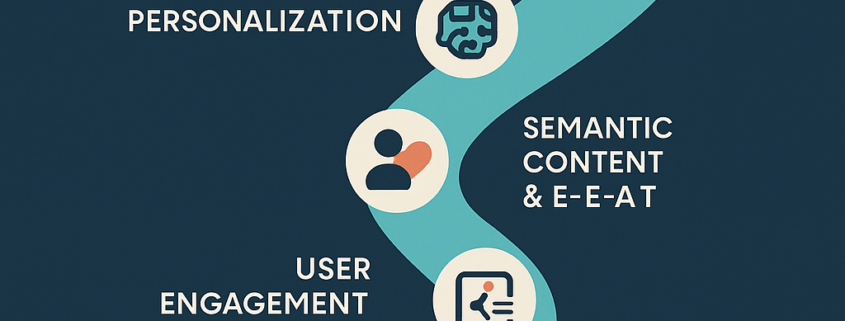How does SEO (Search Engine Optimisation) work? — The 2025 Roadmap
Author: John Lang
Date: 31/05/2025
Search-engine optimisation, or “SEO” for short, has evolved from a keyword-stuffing sideshow to a data-driven, multidisciplinary skill set. Most markets are now highly competitive. To get a company on page one of Google, you must be skilled in search engine optimisation.
This is where we come in.
In 2025, the discipline is less about “tricking Google”, which so many businesses tried in the past, and ended up being “de-indexed”. It’s now more about building an experience (User Experience) so good that ignoring your site would be a disservice to users.
That means rock-solid technical foundations, so for example, making sure every page you want to appear in Google’s index can get indexed.
The content marketing also needs to satisfy search intent, so if someone had a question, such as “what’s the range of average e-bike, then the content marketing should answer this question.
Google E-E-A-T
We highly recommend reading about Google E-E-A-T, as this is crucial to understand before your business begins publishing articles and creating evergreen content marketing.
Your business’s backlink profile screams authority. Done correctly, SEO can help attract a substantial volume of customers. Done poorly, it’s an endless treadmill of lost rankings, penalties such as Google link penalties, and firefighting problems.
What would your company say are the three core Pillars to improve a business’s SEO?
The success of a business’s SEO rests on these three interlocking pillars:
Technical SEO
The foundation of crawl, indexation, and performance. In brief, can Googlebot crawl and index the page?
On-Page SEO and content marketing
Does the content marketing signal relevance, expertise, and engagement? What’s the bounce rate like, for example, on each piece of content marketing?
Off-Page SEO
This is perhaps the most critical area, as the strength of your backlinks can ultimately determine where the business ranks on Google. Good backlinks can help you rank higher, while weak or spam links could even result in your website being deindexed.
Earning authority through high-quality backlinks, brand mentions, and digital PR.
Ignore any one pillar and the structure collapses; therefore, mainly if you operate in a highly competitive niche, such as car insurance, you must spin all of these plates at once. Get all three areas right, and you have a self-reinforcing flywheel: technical excellence (the work can get crawled and indexed by Googlebot), which magnifies content visibility, superior content attracts authoritative do-follow links, and a stronger backlink graph accelerates crawling and indexation.
Technical SEO — Building a fast company website which can be crawled and indexed.
Think of technical SEO as the autobahn for Googlebot. Every roadblock—slow server responses, such as servers timing out, faulty XML sitemaps, or rogue robots.txt rules—forces the crawler to detour or turn back, or give up and start working on crawling and indexing a competitor’s website instead. Treat these checkpoints as non-negotiable:
Crawlability and indexation
Googlebot must be able to crawl and index the work. XML Sitemap and running index coverage reports, your SEO agency monitoring “crawl areas” can help minimise wasted “crawl budgets”.
Submit sitemaps in Google Search Console (GSC) and monitor the Index Coverage report weekly.
Canonical Management – Use <link rel=”canonical”> to Google toward the canonical version of duplicate or near-duplicate URLs and avoid dilution.
Structured data (Schema markup)
Make sure that your SEO consultant implements schema.org markup to improve SERP eligibility for rich results.
- Google Core Web Vitals and speed
- Google’s performance metrics now sit in the ranking core. Aim for:
- Largest Contentful Paint < 2.5 s
- Interaction to Next Paint < 200 ms
- Cumulative Layout Shift < 0.1
Collaborate with your web developers and SEO team to optimise load times. This is especially important on essential pages of your company website, such as the homepage, About Us page, and your main product pages.
Deloitte published exciting data in 202, it was called the “mobile-commerce study”, it found that shaving just 0.1 s off mobile load yielded an 8.3 % bounce-rate reduction– . Speed is revenue.
Mobile
Mobile accounts for roughly 62% of global internet traffic; therefore, as a business in Bristol, you should question whether the mobile design of our company website is as good or better than that of our direct competitors (https://en.wikipedia.org/wiki/Web_browser). Any desktop-only experience is DOA. Embrace responsive design, compress images aggressively, and lazy-load most pages where non-critical assets may be slowing some pages down.
Content marketing
Keyword density is dead – don’t use SEO tools that tell you to hit a percentage to better optimise the page; this doesn’t work. It’s an outdated method of search engine optimisation (SEO).
Keyword Research
Create a content calendar, and write the types of shoppers you are bringing to the page through that work. For example, is the work informational, commercial, transactional, or navigational in intent?
A guide targeting “how to audit an e-commerce SEO stack” deserves different on-page elements than a product page optimised for “buy running shoes size 9”.
Good on-page SEO.
Make sure to optimise your page titles, meta descriptions, and headings using white-hat methods.
Place the primary keyword near the front of the H1 and <title>.
Use descriptive, curiosity-inducing meta descriptions to lift CTR (they may not rank you higher, but better engagement feeds RankBrain-style signals).
Use H2–H6 tags logically; they’re a topical outline for both crawler and skim-reader.
Google E-E-A-T the litmus test
Google’s quality raters guide frames content evaluation around Experience, Expertise, Authoritativeness, and Trustworthiness. Bake in:
Experience – therefore, add business case studies where you have succeeded for your customers or clients, screenshots, and personal data points.
Expertise – show why your company are the expert at what you do.
Authoritativeness – acquire .edu, .gov, or top-tier publication links.
Trust – HTTPS, transparent disclosure pages, and up-to-date author bios.
Content velocity matters, but 72 % of marketers say quality content remains the most effective growth lever (https://contentmarketinginstitute.com/content-marketing-strategy/content-marketing-statistics).
Authority — Off-page SEO Signals
Backlinks (both do-follow and no-follow) are still the loudest off-page ranking signal, but the bar is higher than ever:
Choose digital PR over using spam links, such as directory spam links. A single mention in TechCrunch, BBC, or let’s say another respected website, such as Sky News, beats 1,000 spam sites. Spam links can damage your SEO to the point that the website gets de-indexed, meaning it’s removed from Google. So don’t build low-quality links!
This is about link velocity
Not Volume – sudden spikes trigger spam heuristics. For example, if you had a domain live for, say, 2 years, with no links built, and then all of a sudden you build 100 in a weekend, this is most likely to look like spam. Links need to be built slowly and surely—drip links at a natural cadence aligned with content publication.
Have to stay on top of Google’s algorithm changes.
Because Google’s ranking recipe morphs constantly, Google is continuously improving and changing its algorithm.
The platform shipped ≈approximately 3,200 algorithm changes in 2024 alone, according to a very reliable source at Search Engine Land.
Adaptation is survival.
Further, the rise of Google AI Overviews and SGE (Search Generative Experience) is already shrinking the legacy 10 blue-link clicks: Gartner projects 25 % less classic search volume by 2026.
That’s a clarion call to secure featured visibility— this can be achieved through rich snippets, topical authority clusters, and entity-level knowledge panel citations—before generative SERPs cannibalise click share.
Measurement, maintenance, and the long game
SEO without measurement is like Formula 1 without telemetry. Prioritise these KPIs:
KPI Why It Matters Tool Stack
Organic sessions- tracks how many visitors are coming to the site
Click-Through Rate (CTR – how many shoppers are clicking through and visiting a page on your website?
Dwell Time – How long are shoppers spending on your website? A long time indicates they are interested in the products or services you are selling.
Core Web Vitals – how fast is your company website?
Referring Domains Quality – How many high-quality websites do you have linking to your website, sending link equity?
A slow-and-steady “drip” approach outperforms burst campaigns. Instead of blasting 40 thin posts/content marketing and 200 directory links in a month – this is a recipe for disaster (hello, spam filter) – release one in-depth guide weekly and try to get one or two very high-quality links per month.
FAQ —
What would you say is the single biggest SEO mistake that many businesses make in Bristol regarding their SEO in 2025?
Neglecting Core Web Vitals. This results in a slow website, a high bounce rate, and low dwell times: poor LCP, INP, or CLS scores throttle rankings and conversions.
Next is content marketing quality; many businesses still write 500-word content-thin articles, which often don’t get indexed. Google typically
flags these in Google Search Console as ‘crawled but not indexed,’ indicating low quality.
How long should a modern SEO campaign take to show a return on investment?
We hate to say this word, but it depends.
It depends on the level of competition and the competitiveness of your business sector.
If it’s relatively low competition, experienced SEO agencies like us can get you on page one of Google in a matter of months.
For highly competitive business sectors, it will take much longer.
Expect meaningful uplift after 4–6 months of consistent technical, content, and outreach work—faster in low-competition niches, slower in saturated ones.
Are backlinks still crucial with Google AI Overviews on the rise?
Absolutely. Authority signals (do-follow and no-follow backlinks) influence whether your content is selected as a cited source within those AI summaries.
How often should I audit my site?
Run a light technical crawl monthly to identify broken links or website faults. A full crawl plus content cannibalisation check quarterly, and a holistic strategy review annually or after any major core update.
Should I pause SEO while investing in paid media?
Treat paid and organic as twin engines, yet separate entities: PPC supplies instant visibility and testing data, while SEO compounds long-term rewards if done correctly. Cutting one starves the other of insights.
Bottom Line: SEO success in 2025 is equal parts engineering, editorial rigour by your copywriters, and PR savvy. Master the technical groundwork, publish genuinely helpful content that radiates E-E-A-T, cultivate authoritative citations, and iterate relentlessly with data as your compass. Do that, and you won’t just ride the algorithm waves—you’ll steer the boat.


